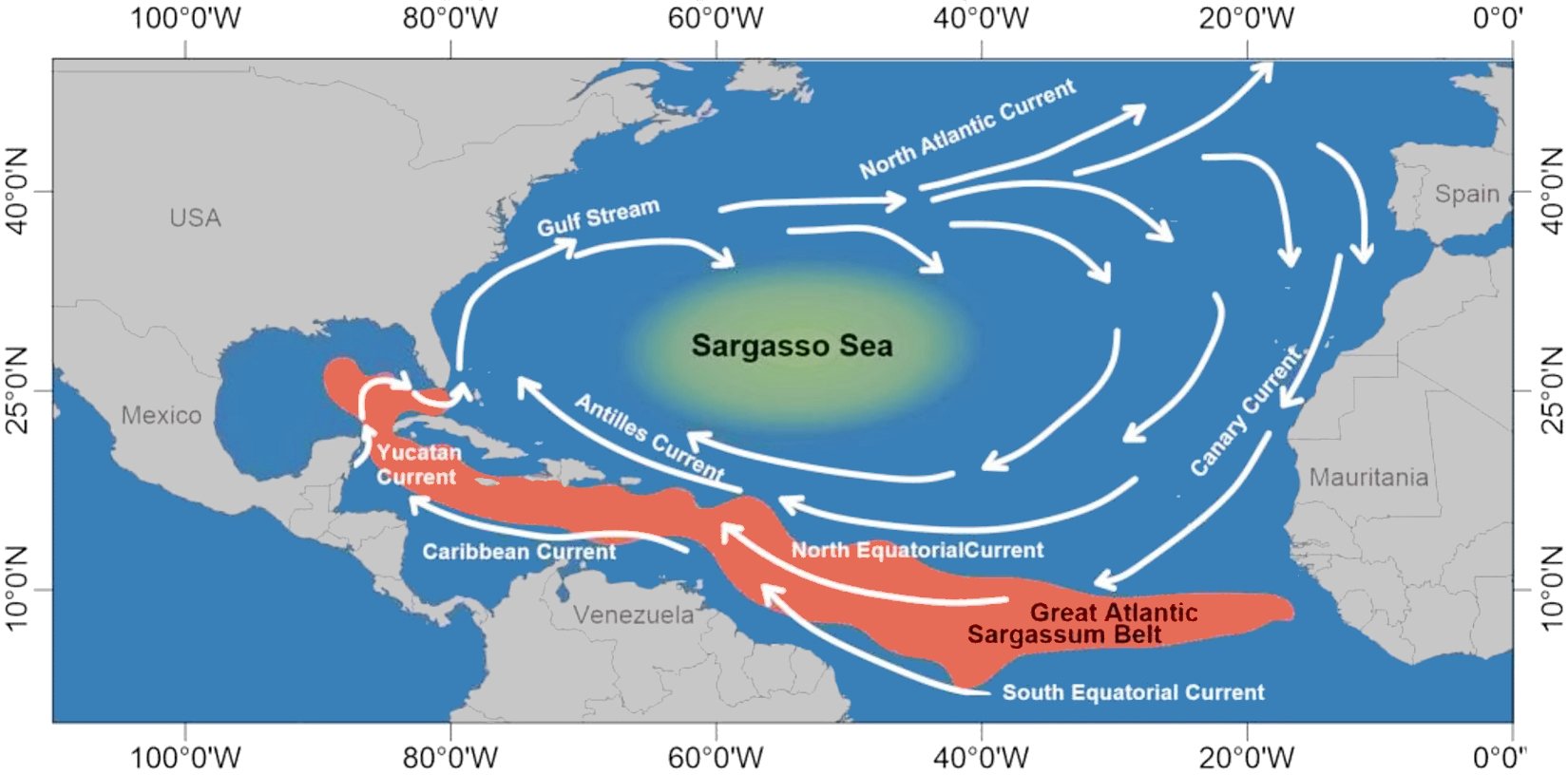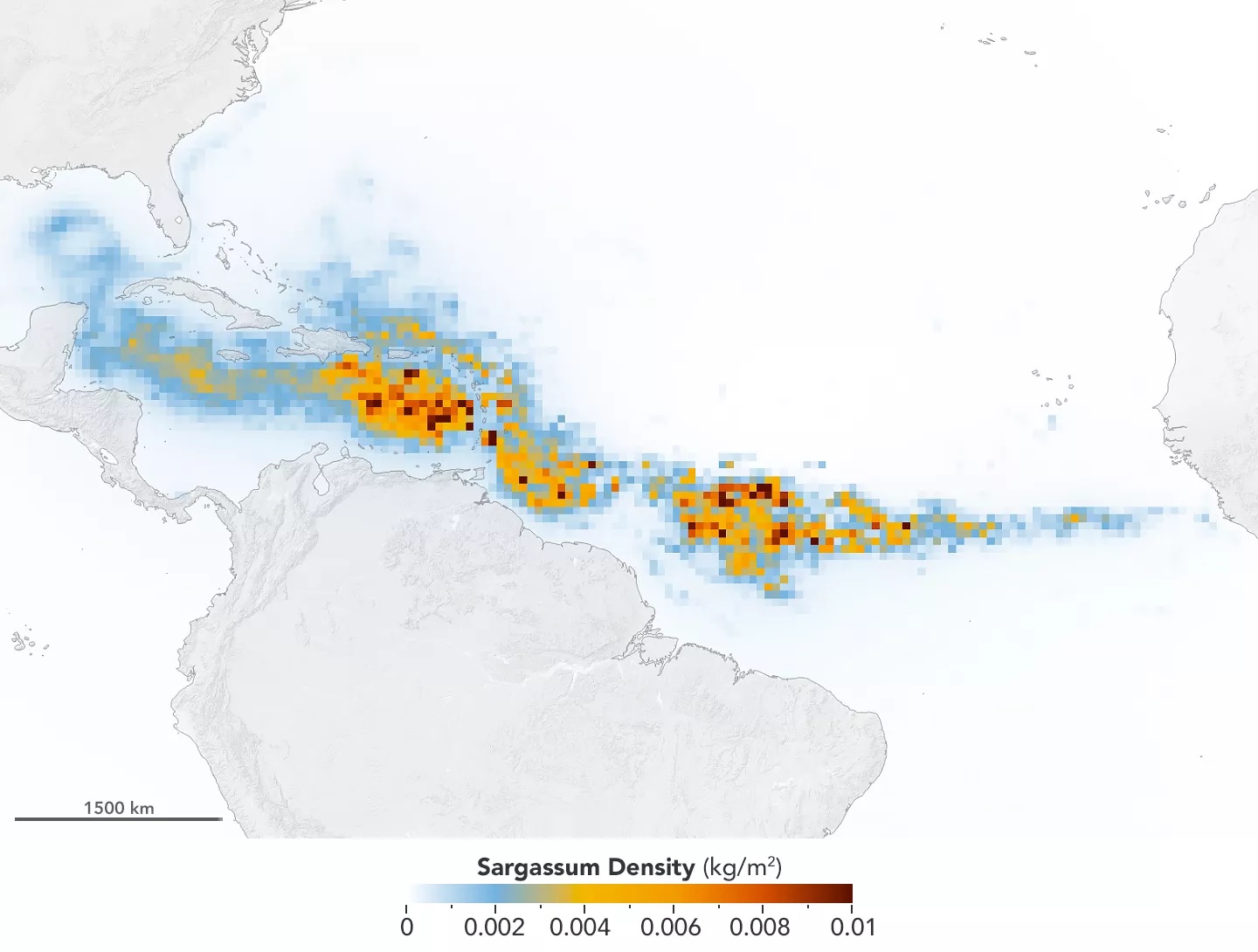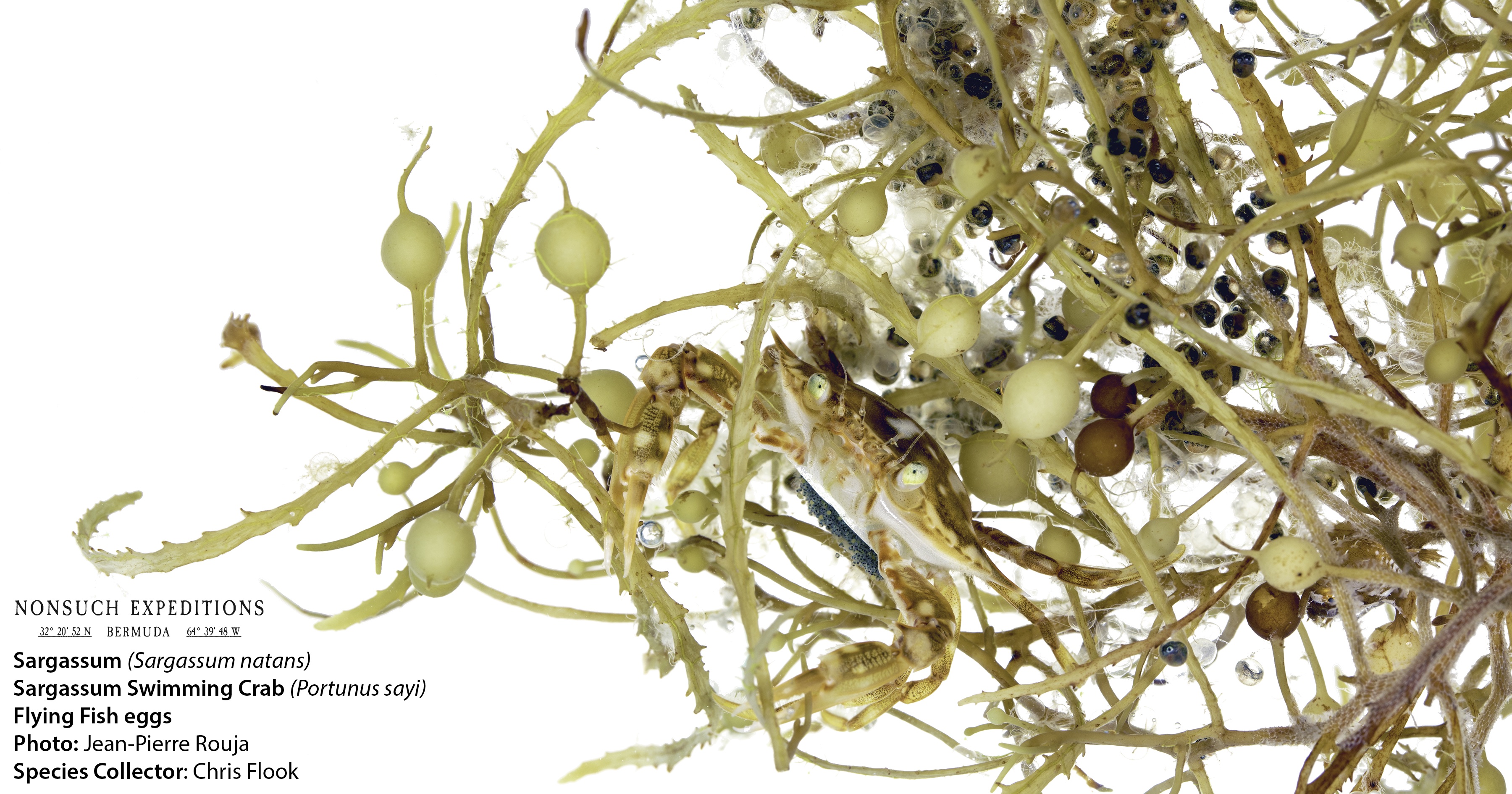What is the Great Atlantic Sargassum Belt?
 Image credit: Wikimedia Commons
Image credit: Wikimedia Commons
Since 2011, large mats of Sargassum have appeared on beaches in many Caribbean states, the coast of Brazil and even the coast of west Africa from Senegal to Nigeria. Sargassum blooms are occurring annually in the spring and summer months in an area stretching from the West Coast of Africa to the Gulf of Mexico commonly referred to as the Great Atlantic Sargassum Belt.
'In 2015 and 2018, the Great Atlantic Sargassum Belt showed the highest coverage, extending > 8850 km and carrying a wet biomass of > 9 million tons (> 20 million tons in June 2018).' (Wang et al, 2019). In 2023, Sargassum made headlines as it was reported that the bloom, stretching 8,047 km, would disrupt tourist season on the Eastern coast of the United States.
How do the mass strandings affect people?
The impact of these mass strandings on local economies can be severe, affecting tourism and recreation, because the mats are difficult to dispose of and are unsightly and smelly as they decompose. The hydrogen sulfide gas Sargassum emits as it decomposes can even irritate the skin or cause respiratory and neurocognitive problems.
Sargassum also absorbs heavy metals, and it has been found to contain levels of arsenic that 'could well give cause for concern across all potential applications, in particular for human and animal use. Similarly, there are concerns for the widespread applications or disposal of this [Sargassum] biomass due to environmental impacts in the case of storage, landfill or composting,' (Devault et al. 2020 via Oxenford 2021).
Also, Caribbean fishermen are noting substantial fishery changes: the local flying fish in many areas have left and juvenile mahi mahi or dolphinfish are being reported in large numbers with the presence of the Sargassum. There are also reports of new and unfamiliar species in Caribbean waters with Sargassum.
What is causing the blooms?
The causes of these mass blooms and strandings are unclear, but scientists are looking at different cause and effect scenarious including nutrient availability from the Amazon and Orinoco Rivers, and warmer surface temperatures and changes in circulation associated with climate change (Franks et al 2011, 2016, Johnson et al 2012, Smetacek and Zingone 2013).
In a 2021 article, Lapointe et al. found that concentrations of nitrogen in Sargassum were 35% higher than samples from 30 years earlier, suggesting that runoff from farms and sewage may be a contributing factor to Sargassum blooms.
Another hypothesis is that dust from the Sahara Desert being swept up and rained down into the ocean as iron and phosphorous contribute to the blooms.
Where does the Sargassum come from?
 Image credit: NASA/Earth Observatory, 2019
Image credit: NASA/Earth Observatory, 2019
The source of the Sargassum inundating beaches in Western Africa, the Caribbean, and the Eastern US is not suspected to be Sargassum drifting from the Sargasso Sea, but Sargassum germinating in the north equatorial recirculation region (NERR) south of the Sargasso Sea between the north equatorial current and the equator. Sargassum particle simulations suggest that 'some Sargassum may enter the Central Atlantic from West Africa and bloom there. Field measurements of species compositions also suggest that the Sargasso Sea is unlikely to have induced the major blooms in the Central Atlantic.' (Wang et al, 2019). The 2011 blooms were tracked using satellite imagery by Gower et al (2013) to an area north of the mouth of the Amazon.
Studies suggest the Sargasso Sea and the Great Atlantic Sargassum Belt NERR represent two distinct populations of Sargassum. An expedition from the Sea Education Association revealed that the Sargassum in the NERR is morphologically different from the Sargassum in the Sargasso Sea. There are many species of Sargassum, but only two are pelagic - S. natans and S. fluitans, but these two species are highly morphologically diverse. The SEA expedition identified the S. natans I and S. fluitans III morphological forms to be the most predominant in the Sargasso Sea, and the most predominant form inundating the Caribbean as S. natans VIII - and this morphological type has also been found to support a less diverse rafting community.
Why is Sargassum important?

Sargassum is a genus of golden brown macroalgae (seaweed), which has numerous species throughout the world oceans - however only two are holopelagic, floating freely on the high seas and reproducing vegetatively - S. natans and S. fluitans.
When Sargassum inundates beaches outside of its usual range it can smother reefs and seagrass beds, disrupt tourism, and create a smelly and sometimes hazardous environment for humans.
However, in its usual range on the Sargasso Sea it acts as critical nursery habitat for many species. It supports ten endemic species, including fish and invertebrates specialised to live their whole lives within floating Sargassum. It also acts as critical fish habitat - flying fish lay their eggs in it, and it shelters many species of pelagic fish that grow to be ocean giants, such as tripletails and dolphinfish. It also provides crucial developmental habitat for at least three species of Atlantic sea turtle, which spend their first years developing in Sargassum on the high seas after they leave the nesting beach. This proliferation of life in Sargassum in turn supports other organisms which feed beneath it, and it acts as the basis for the iconic Sargasso Sea ecosystem. The Sargasso Sea also acts as a significant carbon sink, representing ca. 7% of the global biological carbon pump, and this is aided by the sinking of Sargassum to the deep sea when it reaches the end of its life cycle. The biodiversity and ecosystem services provided by the Sargasso Sea has driven international interest in its conservation.
For more information, consult our 2011 science case.
Who is tracking Sargassum presence?
Experts from the University of South Florida and the University of Southern Mississippi are among those who are exploring the tracking of Sargassum presence.
The Sargassum Information Hub also provides information and visualisation tools for Sargassum. There you can find links to satellite data for several areas in near real-time, showing an AFAI (Alternative Floating Algae Index) image to detect materials floating on the surface (Sargassum, Trichodesmium, etc), and a CI (Color Index) image to trace ocean circulation features.
Citations
Devault, D.; Ménez, F.; Péné-Annette, A.; Lopez, P.J. Eco3Sar: Ecologie, Ecotoxicologie et Economie des Sargasses; Agence de la Transition Ecologique (ADEME): Angers, France, 2020; p. 126.
Franks, J.S., D.R. Johnson, D.S. Ko, G. Sanchez—Rubio, J.R.Hendon, and M. Lay. 2011. Unprecedented influx of pelagicSargassum along Caribbean island coastlines during summer2011. Proceedings of the Gulf and Caribbean Fisheries Insti-tute 64:6—8
Franks, J.S., D.R. Johnson, and D.S. Ko. 2016. Mass strandingsof pelagic Sargassum along Caribbean and West Africa Coast-lines: Understanding and prediction. Proceedings of the Gulfand Caribbean Fisheries Institute 68:402—408
Gower, J. (2013). Satellite images suggest a new Sargassum source region in 2011. Remote Sensing Letters, 4(8), 764-773. DOI: https://doi.org/10.1080/2150704X.2013.796433
Johnson, D., Ko, D. S., Franks, J. S., Moreno, P., Sanchez-Rubio, G. The Sargassum Invasion of the Eastern Caribbean and Dynamics of the Equatorial North Atlantic. Conference Item, Aqua Docs. http://hdl.handle.net/1834/36258
Laffoley, D.d'A.1, Roe, H.S.J.2, Angel, M.V.2, Ardron, J.3, Bates, N.R.4, Boyd, I.L.25, Brooke, S.3, Buck, K.N.4, Carlson, C.A.5, Causey, B.6, Conte, M.H.4, Christiansen, S.7, Cleary, J.8, Donnelly, J.8, Earle, S.A.9, Edwards, R.10, Gjerde, K.M.1, Giovannoni, S.J.11, Gulick, S.3, Gollock, M. 12, Hallett, J. 13, Halpin, P.8, Hanel, R.14, Hemphill, A. 15, Johnson, R.J.4, Knap, A.H.4, Lomas, M.W.4, McKenna, S.A.9, Miller, M.J.16, Miller, P.I.17, Ming, F.W.18, Moffitt, R.8, Nelson, N.B.5, Parson, L. 10, Peters, A.J.4, Pitt, J. 18, Rouja, P.19, Roberts, J.8, Roberts, J.20, Seigel, D.A.5, Siuda, A.N.S.21, Steinberg, D.K.22, Stevenson, A.23, Sumaila, V.R.24, Swartz, W.24, Thorrold, S.26, Trott, T.M. 18, and V. Vats1 2011. The protection and management of the Sargasso Sea: The golden floating rainforest of the Atlantic Ocean. Summary Science and Supporting Evidence Case. Sargasso Sea Alliance, 44 pp.
Lapointe, B. E., Brewton, R. A., Herren, L. W., Wang, M., Hu, C., McGillicuddy Jr., D. J., Lindell, S., Hernandez, F. J., Morton, P. L. (2021). Nutrient content and stoichiometry of pelagic Sargassum reflects increasing nitrogen availability in the Atlantic Basin. Nature Communications, 12(1). DOI: 10.1038/s41467-021-23135-7
Oxenford, H.A., Cox, S.-A., van Tussenbroek, B.I., Desrochers, A. (2021). Challenges of Turning the Sargassum Crisis into Gold: Current Constraints and Implications for the Caribbean. Phycology, 1(1), 27-48. https://doi.org/10.3390/phycology1010003
Schell, J.M., D.S. Goodwin, and A.N.S. Siuda. 2015. Recent Sargassum inundation events in the Caribbean: Shipboard observations reveal dominance of a previously rare form. Oceanography 28(3):8–10, http://dx.doi.org/10.5670/oceanog.2015.70.
Semetacek, V. and A. Zingone. 2013. Green and golden seaweedtides on the rise. Nature 504:84—88. doi: 10.1038/nature1286
Wang, M., Hu, C., Barnes, B., Mitchum, G., Lapointe, B., Montoya, J. P. (2019). The Great Atlantic Sargassum Belt, Science, 365(6448), 83-87. DOI: 10.1126/science.aaw7912
Wattles, J., and Rogers, K. (2023). A seaweed blob twice the width of the US is heading toward Florida. Here's what you should know, CNN. Accessed 15 May 2023, https://edition.cnn.com/travel/article/sargassum-seaweed-blob-explained-florida-scn/index.html
Reporting
If you have a Sargassum event to report, the Sargasso Sea Commission recommends reaching out to the following experts directly:
Dr. Jim Franks
University of Southern Mississippi
Gulf Coast Research Laboratory (GCRL)
Ocean Springs, Mississippi USA
This e-mail address is being protected from spambots. You need JavaScript enabled to view it
http://www.usm.edu/gcrl/cv/franks.jim/cv.franks.jim.php
Dr. Chuanmin Hu
University of South Florida
College of Marine Science
St. Petersburg, Florida USA
This e-mail address is being protected from spambots. You need JavaScript enabled to view it
http://www.marine.usf.edu/faculty/chuanmin-hu/85-chuanmin-hu
Where can I learn more?
The SPAW-RAC and SPAW Secretariat of UNEP-CEP in collaboration with the Association of Caribbean States, the Centre for Resource Management & Environmental Studies (CERMES - UWI), the Sargasso Sea Commission and UNEP-Global Programme of Action and Global Partnership on Nutrient Management hosted a technical session "Understanding and management of the pelagic Sargassum influx in the Caribbean" during the 69th GCFI annual meeting in Grand Cayman on November 10th. This session provided the latest scientific information on the origin of the Sargassum influx with consideration of oceanographic, climatological, ecophysiological characteristics (links with nutrient increases) as well as the genetic properties of the algal species involved and their associated fauna. There was also a focus on the current status of the forecasting research that highlighted existing data and expertise for setting up short-term predictions, and further described the ongoing efforts and progress towards developing long-term prediction in forecasting future potential landings. Click here for the video. The presentations of the technical session and a synopsis of the events are available on SPAW-RAC website.
The following links on worldwide Sargassum created by other organizations may be helpful.
Sea Education Association Sargassum Research
Sargassum Information Hub (organized by the GEO Blue Planet, IOCARIBE of IOC-UNESCO, AtlantOS, and the Atlantic International Research (AIR) Center)
The Science of Sargassum webinar (UNEP, July 2020)
Networking Fridays Thematic Special Session on Sargassum (July 2020)
International Conference on Sargassum (Guadalupe, October 2019)
French-American Workshop on Sargassum (Texas A&M Galveston, January 2018)
Model Protocol for the Management of Extreme Accumulations of Sargassum on the Coasts of CRFM Member States. 2016. Caribbean Regional Fisheries Mechanism.
Doyle, E. and J. Franks. 2015. Sargassum Fact Sheet. Gulf and Caribbean Fisheries Institute
UNEP, September 2015. Concept Note on West African Sargassum
Ecological Society of America. Sargassum Accumulation Trouble for Nesting Sea Turtles
Smetacek and Zingone 2013. Green and Golden Seaweed Tides on the Rise
Webster and Linon 2013. Development and Implementation of a Sargassum Early Advisor System
August 2015 Information from Guadeloupe (French only)
2013 Information from Galveston Texas
The Tropical Atlantic Sargassum Story 2011-2021 Presentation by Dr. Hazel Oxenford, 2021. This presentation was part of the 2021 AllAtlantic R&I conference for a Sustainable Ocean - watch the video here.


